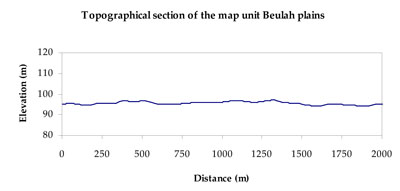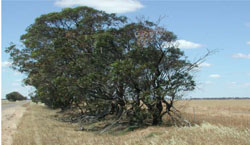Soil/Landform Unit - Beulah plains
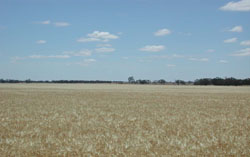 Cropped plains near Beulah |
1.16% of CMA region Located in the north-east of the region, the Beulah plains soil-landform unit form part of the CalcareousNorth West Dunefields and Plains (5.1.5) where hummocky dunes are sub-dominant. The landscape is dominated by plains with cracking clay soils (Vertosols), and calcareous gradational soils (Calcarosols), with minor rise crests and slopes with hummocks having sodic red texture contrast soils (Sodosols). Dryland cereal cropping is the major land use with soils prone to compaction at critical moisture contents. Plains Savannah and Ridged Plains Mallee vegetation communities are associated with the plains, while rises are associated with vegetation communities such as Low Rises Woodland. | 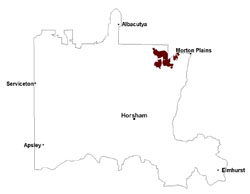 |
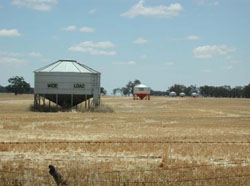 Cereal cropping field bins sout-east of Lah | 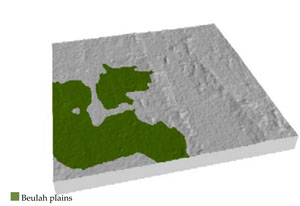 |
|
|
Component | 1 | 2 | 3 |
Proportion of soil-landform unit | 5% | 15% | 80% |
| CLIMATE Rainfall (mm) | Annual: 360 | ||
| Temperature (oC) | Minimum 9, Maximum 22 | ||
| Precipitation less than potential evapotranspiration | September–April | ||
| GEOLOGY Age and lithology | Neogene marine sand and silt (Parilla Sand); Quaternary fluvial silt, sand and minor gravel (Shepparton Formation) | ||
| Geomorphology | |||
| LANDUSE | Uncleared areas: nature conservation Cleared areas: dryland cropping; sheep grazing | ||
| TOPOGRAPHY Landscape | Gently undulating plains | ||
| Elevation range (m) | 92–119 | ||
| Local relief (m) | 3 | ||
| Drainage pattern | Dendritic | ||
| Drainage density (km/km2) | 0.4 | ||
| Landform | Plains | ||
| Landform element | Risecrest (hummock) | Rise slope (hummock) | Plain |
| Slope and range (%) | 3 (1-7) | 5 (3-10) | 3 (1-8) |
| Slope shape | Convex | Linear | Straight |
| NATIVE VEGETATION Ecological Vegetation Class | Plains Savannah (47.3%), Ridged Plains Mallee (22.2%), Plains Woodland (10.6%), Low Rises Woodland (9.2%), Other (3.9%) | ||
| SOIL Parent material | Marine sand and silt | Marine sand and silt | Fluvial silt, sand and minor gravel |
| Description (Corangamite Soil Group) | Sodic red texture contrast soils (27) | ||
| Soil type sites | |||
| Surface texture | Sandy loam | Sandy loam | Sandy clay loam |
| Permeability | Moderate | Moderate | Slow to moderate |
| Depth (m) | > 2 | > 2 | > 2 |
| LAND CHARACTERISTICS, POTENTIAL AND LIMITATIONS Critical land features, processes, forms | Loose surface susceptible to sheet and rill erosion along with wind erosion. Dispersive and deep subsoils susceptible to gully erosion on steeper slopes. Soils are prone to compaction at critical moisture contents. | Wind erosion along with sheet and rill erosion occur on surfaces with little organic matter. Subsoils are dispersive and susceptible to gully erosion on steeper slopes where exposed. Soils compact at critical moisture contents. | Soils can be subject to inundation and waterlogging especially on low-lying flats. Soils may be susceptible to compaction. |

